THE SUN'S CROWN
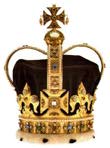
Why does a burning candle not look as bright in daylight as it does in
a dark room? Well daylight is much brighter than the candle and it
swamps the light from it making it hard to see. The same thing
happens with the Sun's atmosphere.
|
The Sun's atmosphere, which we call the corona, is made of very hot gas
and stretches far out into space. It scatters light from the Sun in all
directions. This scattered light is dim compared to the light coming
directly from the Sun and
because of this we can't normally see the corona or CMEs. During a total solar eclipse
however, the Sun's disc is covered by the moon and the Sun's atmosphere
becomes visible as a shining ring around the moon.
Since this shining ring reminded people of a crown it was called the
corona, which means crown. So the Sun really is King (or Queen, ed.) of the solar
system!
Image courtesy of the High Altitude Observatory, Boulder, USA.
|
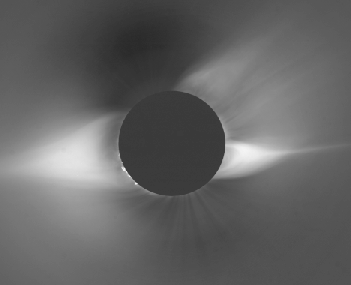
|
Thanks to a Frenchman named Bernard Lyot (here seen working
at a telescope in a photo from the Pic du Midi observatory in France)
who invented the coronagraph in 1930, we can
look at the corona anytime we want. Remember that a coronagraph is
just a telescope with a disc that blocks out the bright light from the
Sun and lets us see the surrounding corona.
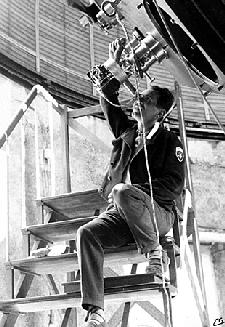
However, even though Lyot's coronagraph was a great invention, we always get a better
look at the corona from space because there is no air
and no clouds! The coronagraph on SOHO is called LASCO and it gives us
an amazing view of the corona, better than ever before and much better
than watching a total solar eclipse. This helps us in our work to
figure out how the Sun works.
WHAT DOES THE CORONA LOOK LIKE USING MODERN SPACE INSTRUMENTS?
LASCO has three telescopes called C1, C2 and C3. This gives us three
different views of the corona. During the quiet time of the Sun's
cycle most of the gas in the corona is in long features called
coronal streamers.
These stretch a long way into space like arms and look
bright because they contain a lot of hot gas that scatters the Sun's light.
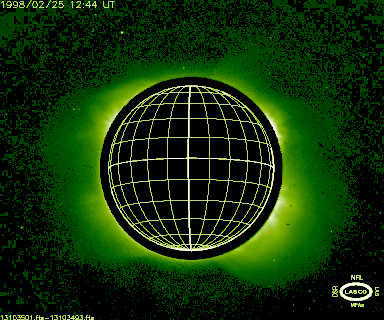
Image courtesy of the LASCO/SOHO consortium. SOHO is a mission of international cooperation between of ESA and NASA.
The corona's million
degree temperature means that it emits light. This picture from the
LASCO C1 telescope shows this light
(C1 works differently than C2 and C3 which both record scattered light).
The magnetic field that comes from the Sun forms the gas into large
arcs. C1 shows us what the corona looks like from near the Sun's surface out to
about two or three million kilometres.
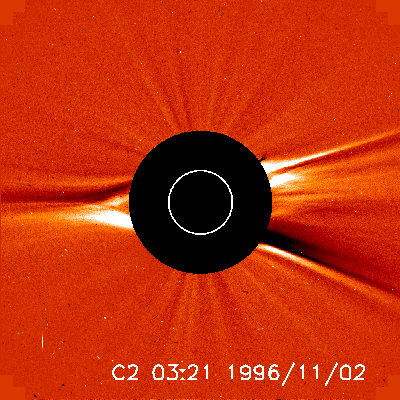
Image courtesy of the LASCO/SOHO consortium. SOHO is a mission of international cooperation between of ESA and NASA.
This picture, taken by the LASCO C2 telescope shows the
corona in the range 1.3 to 4.0 million kilometres from
the Sun. The C2 telescope records light that is scattered from the
electrons in the corona. Most of the gas is concentrated into three
long streamers.
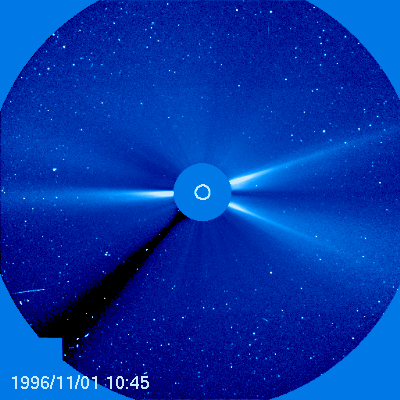
Image courtesy of the LASCO/SOHO consortium. SOHO is a mission of international cooperation between of ESA and NASA.
This is a picture taken by the LASCO C3 telescope which also records
scattered light from the corona. The C3 telescope shows us what the
corona looks like from about 4 million to 21 million kilometres
from the Sun! Again most of the gas is concentrated into three very
long streamers (remember the white circle in the middle marks the
position of the Sun and shows its size). The black streak in the
picture is caused by the post that holds the occulting disc in place.
Longer than 2,000 Earths placed side by side!
When the Sun gets more active so does the corona. We see many more
streamers and more CMEs!
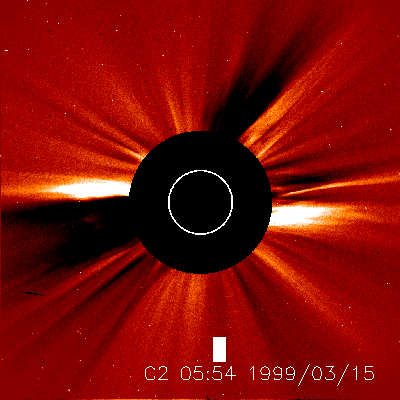
Image courtesy of the LASCO/SOHO consortium. SOHO is a mission of international cooperation between of ESA and NASA.
Follow this link
to see a movie (QuickTime, 2Mb) of the Sun's
atmosphere in playful mood!







